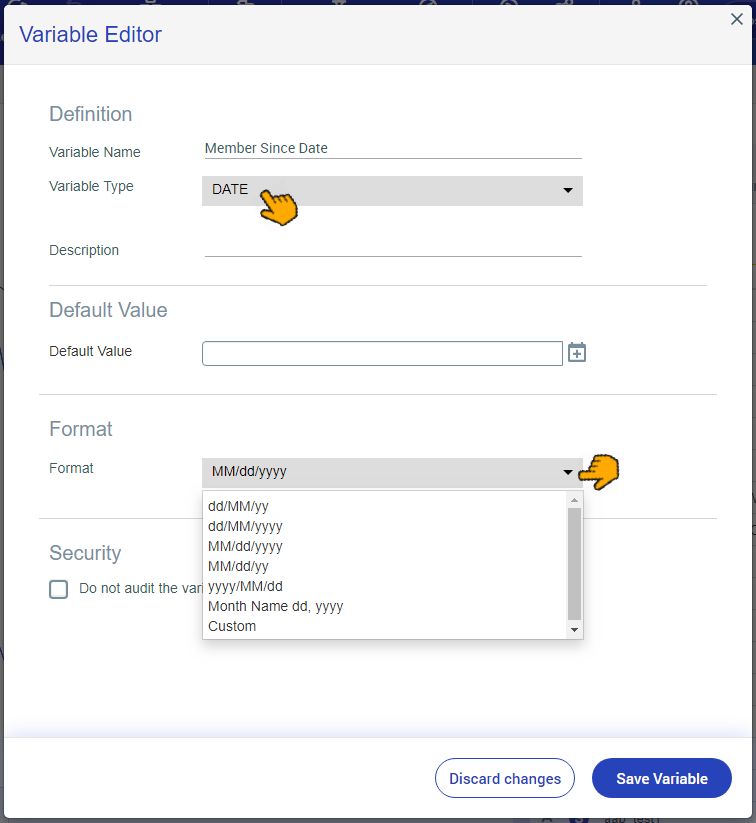Designing Variable Display Formats
Most Flows contain multiple variable types. The input for these variables can come from many different sources, such as data from user input, responses from Integration Points, or results of internal calculations in the Flow.
Some variable types can be displayed in different formats, for example:
A number can be displayed with or without a decimal point
A date can be shown in a format that uses words (e.g., May, June) as well as numbers
A number representing an amount of currency can be displayed together with its currency symbol
The Format option lets you define any specific formatting required.
Note
When special formatting is defined for a data type, the specified formatting appears only when the variable is displayed on a Page (e.g., in a Paragraph element). The special formatting will not be displayed during data input (e.g., while the user is answering an input question).
Using the Format Option
The Format field is enabled whenever creating a variable of the type Number, Date, or Text (or a Collection of one of these simple types):
 |
Formatting options will vary according to the variable type, as detailed in the following sections.
Formatting Text Variable Types
 |
The text formatting field enables you to define a text pattern for user input. For example, the formatting shown above can be the pattern for a US telephone number.
Formatting Number Variable Types
 |
Number formatting options include the following settings:
Setting | Description |
|---|---|
Decimal Places | Allows you to specify how many decimal places will be shown. |
Symbol | Allows you to specify the symbol that will be placed before or after a currency value. |
Locale | Select the required locale from the dropdown list. The format of the separators in the number (for thousands and decimal points) are displayed according to the custom in the selected locale. |
Position | Allows you to specify whether the related currency symbol appears before or after the number. |
Show thousands separator | This checkbox determines whether or not thousands separators are displayed (e.g., 1,000 vs. 1000). |
Formatting Date Variable Types
 |
Date formatting options allow you to select from or build the following date formats:
Setting | Example | Description |
|---|---|---|
MM/dd/yy | 10/15/17 | US Short Date |
MM/dd/yyyy | 10/15/2017 | US Short Date with Full Year |
dd/MM/yy | 15/10/17 | Short Date |
dd/MM/yyyy | 15/10/2017 | Short Date with Full Year |
yyyy/MM/dd | 2017/10/15 | Short Date with Leading Full Year |
Month Name dd, yyyy | October 15, 2017 | Long Date |
Custom | 15.10.17 17.10.15 2017-10-15 | Enter your new format in the field that appears below the dropdown list. The following are some examples of valid custom date formats, with each result displayed in the column to the left: dd.MM.yyyy.MM.ddyyyy-MM-dd As shown above, you can also customize any standard, built-in format by substituting a hyphen (-) or a period (.) in place of the slash (/). If your custom format entry actually matches one of the built-in formats, the name of the built-in format option will appear here when you edit the variable. |
Important
When comparing two Date values using a logical operator, the stored values will include milliseconds. For this reason, compared values may differ even though the displayed Date value is the same. For more details, click here.